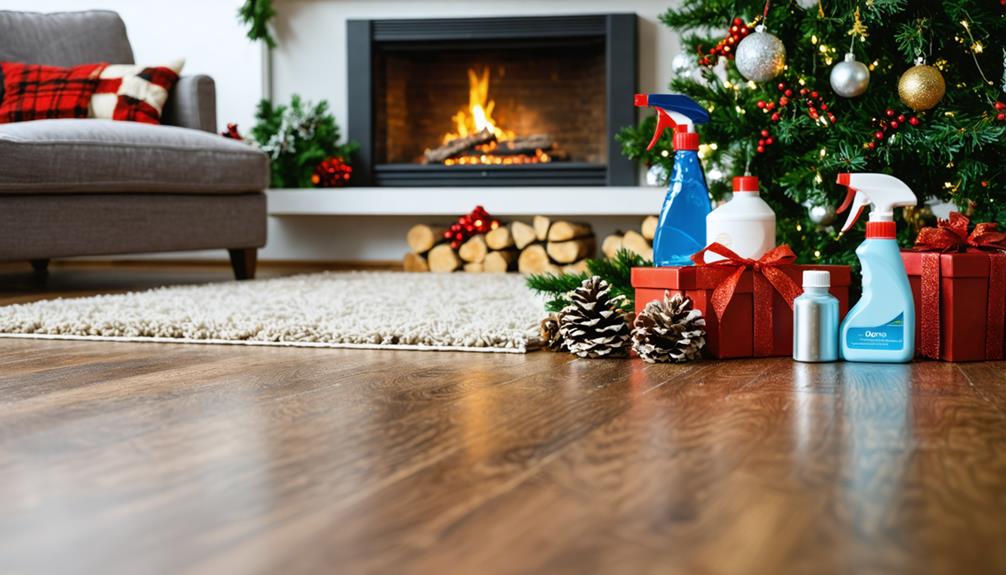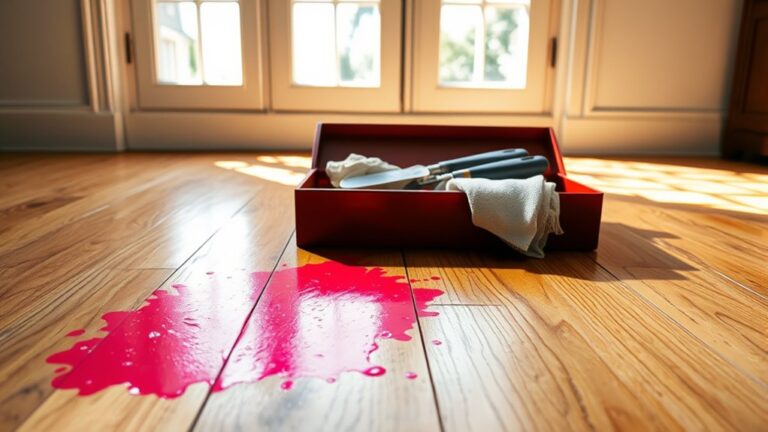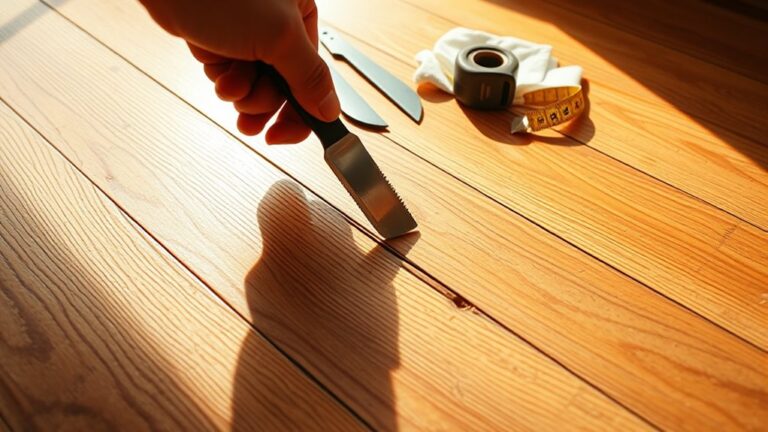To winterize your hardwood floors, start by placing high-quality floor mats at all entry points. These mats help trap dirt, moisture, and salt, preventing damage. Implement a no-shoe policy indoors to further reduce tracked debris. Maintain indoor humidity between 30-50% to prevent wood from drying out or cracking. Regularly vacuum with a soft brush attachment and use pH-balanced cleaners for cleaning. Promptly address spills to avoid warping, and inspect for any leaks. For more effective strategies and maintenance tips, there's plenty more to contemplate as winter approaches.
Importance of Winter Maintenance
When it comes to maintaining hardwood floors during the winter months, understanding the importance of winter maintenance can't be overstated. Your hardwood floors are particularly vulnerable to damage from ice, snow, and salt, making proactive care essential. Cold temperatures can lead to decreased humidity in the air, causing the wood to dry out. This drying can result in cracks and long-term structural issues, which are costly to repair.
Implementing regular winter maintenance is vital for preserving both the aesthetic appeal and value of your floors. By incorporating simple practices, you can greatly extend the lifespan of your hardwood flooring. Start by using sol mats at entry points to trap dirt and moisture, which prevents them from scratching and damaging your floors. Encouraging family and guests to remove their shoes before entering can also help protect your floors from harmful debris.
Neglecting these winter maintenance measures can lead to unsightly white salt residues and deep scratches that detract from the overall appearance of your hardwood. Regular cleaning and protective measures will not only keep your floors looking pristine but will also contribute to a healthier indoor environment by maintaining an appropriate humidity level. So, as the winter months approach, prioritize these maintenance strategies to protect your floors from seasonal challenges, ensuring they remain beautiful and structurally sound for years to come.
Protecting Hardwood Floors
To protect your hardwood floors during winter, consider investing in high-quality floor mats at entrances to trap dirt, sand, and salt. Implementing a no-shoe policy indoors can notably reduce the moisture and debris that gets tracked onto your floors. These simple practices can help maintain the beauty and integrity of your hardwood surfaces throughout the season.
Effective Floor Mats
Effective floor mats play an essential role in protecting hardwood floors during the winter months. High-quality walk-off mats can absorb up to 90% of dirt and moisture from shoes, considerably lowering the risk of damage. By placing effective floor mats at both indoor and outdoor entry points, you can trap debris and moisture before it reaches your hardwood surfaces, preventing scratches and residue buildup.
Choosing thick, durable mats is fundamental, as they withstand heavy foot traffic and harsh winter elements. It's also important to regularly clean and dry these mats. Wet mats can harbor mold and mildew, which adversely affect both the mats and your hardwood floors. By maintaining proper moisture levels in your entryway, you help guarantee the longevity of your flooring.
Implementing a family policy of removing shoes on mats will further enhance your floor protection, keeping hardwood floors cleaner and reducing maintenance needs. This simple practice, combined with effective floor mats, creates a strong defense against the winter challenges your hardwood floors face. By taking these steps, you can enjoy your beautiful hardwood floors all season long, free from the wear and tear that comes with winter weather.
Shoe Removal Practices
A no-shoe policy can dramatically enhance the protection of your hardwood floors during winter. Implementing effective shoe removal practices helps to notably reduce the dirt, moisture, and salt tracked indoors, preserving the appearance and integrity of your flooring. Encourage guests to remove their shoes upon entering, as this minimizes the risk of scratches and damages caused by outdoor debris.
Walk-off mats are essential tools in this process. They can absorb up to 90% of dirt and moisture from shoes, making a significant difference in protecting your hardwood surfaces. Position these mats at entry points to catch the bulk of contaminants before they reach your floors.
Furthermore, when dealing with wet shoes, it's vital to place them away from hardwood areas and dry them promptly. This practice prevents water damage and moisture accumulation that can harm your floors over time. Regularly reminding household members about these shoe removal practices cultivates a culture of cleanliness and care, ensuring everyone plays their part in protecting your investment. By taking these simple steps, you'll maintain the beauty and longevity of your hardwood floors throughout the winter months.
Preventing Moisture Damage
During the winter months, preventing moisture damage to hardwood floors is essential for maintaining their integrity and appearance. To start, it's important to wipe up spills or moisture immediately. Prolonged exposure can lead to seepage, causing warping and discoloration that can be costly to repair.
Maintaining indoor humidity levels between 30-50% is also critical. This range helps prevent wood shrinkage and minimizes the formation of gaps as temperatures fluctuate. When humidity drops too low, you risk cracks and splits in your hardwood flooring, which can compromise its durability.
Using high-quality mats at exterior doors is an effective strategy to catch moisture and debris before they reach your floors. This simple addition greatly reduces the risk of damage, allowing you to enjoy your beautiful hardwood without worry.
Regularly check for leaks or water accumulation near your hardwood flooring. Addressing potential moisture issues promptly can prevent extensive damage down the line. If you notice any dampness, take immediate action to rectify the situation, whether it's mopping up water or sealing leaks.
Effective Cleaning Techniques
To keep your hardwood floors in prime condition during winter, consistent vacuuming is essential for removing dirt and debris that can scratch the surface. You'll also want to choose appropriate cleaning products designed specifically for hardwood to prevent damage. Establishing a cleaning routine will guarantee your floors remain beautiful and protected throughout the season.
Regular Vacuuming Practices
Keeping hardwood floors pristine in winter requires regular vacuuming practices that effectively combat the accumulation of abrasive particles. During these months, salt, sand, and dirt can be tracked indoors, posing a risk to your floor's finish. To minimize damage, vacuum at least once a week, and increase frequency near entryways where debris tends to collect.
Utilize a vacuum equipped with a soft brush attachment; this allows you to gently lift dust and debris without scratching the hardwood surface. It's essential to empty the vacuum's canister or replace the bag regularly to maintain maximum suction and prevent redistributing particles back onto the floor.
Additionally, implement a routine that encourages family members and guests to remove their shoes upon entering your home. This simple practice can greatly reduce the amount of dirt and debris that finds its way onto your floors, lessening the need for extensive vacuuming. By establishing these regular vacuuming habits, you'll not only protect your hardwood floors but also enhance their longevity, allowing you to enjoy their beauty throughout the winter season.
Appropriate Cleaning Products
Maintaining the beauty and integrity of hardwood floors requires the right cleaning products and techniques. To effectively clean hardwood floors, always opt for hardwood-specific cleaners that are pH balanced. This prevents any damage to the floor's finish. Be certain to read labels for compatibility with your flooring type.
Regular cleaning is crucial. Use a microfiber mop and a slightly damp cloth to keep hardwood floors free from excess moisture, which can warp the wood. Avoid harsh chemicals or abrasive tools that can scratch and dull the surface. For spills, spot-clean immediately with a soft, damp cloth to prevent staining.
Before using any new cleaning product, test it on a small, inconspicuous area to verify it won't harm the finish.
| Recommended Products | Avoid These Products |
|---|---|
| Hardwood-specific cleaners | All-purpose cleaners |
| Microfiber mops | Abrasive scrubbing pads |
| Soft cloths | Harsh chemicals |
Repairing Floor Damage
Addressing floor damage promptly is important for preserving the beauty and durability of your hardwood floors. Minor scratches can often be easily repaired by using a color-matched crayon or furniture polish, effectively concealing the damage without the need for extensive repairs. However, if you notice deeper scratches or dents, you'll likely need to sand and refinish the affected areas. This process restores the floor's original appearance while also protecting its surface.
Regular inspections of your hardwood flooring are key in identifying cracks or gaps early on. By catching these issues before they escalate, you can prevent more extensive damage and costly repairs down the line. Inspect your floors every few months, checking for signs of wear and moisture damage. If you spot significant issues, it's advisable to think about professional repair services. These experts possess the necessary skills and tools to guarantee high-quality restoration, potentially saving you time and hassle.
Additionally, maintaining a clean and dry environment is essential for your hardwood floors. This practice not only helps prevent new damage but also prolongs their lifespan through proper care. Use appropriate cleaning products and avoid excess moisture to keep your floors in best condition.
Long-Term Care Strategies
A proactive approach to long-term care for hardwood floors is vital for preserving their beauty and extending their lifespan. By implementing effective strategies, you can help to keep your hardwood flooring in peak condition, especially during harsh winter months. Here are four good ideas to take into account:
- Regular Refinishing: Refinish your hardwood floors every 3-5 years. This helps maintain protective layers and enhances durability against winter conditions, ensuring your floors stay looking fresh and vibrant.
- Use Area Rugs: Place area rugs in high-traffic zones. This minimizes wear and tear during colder months when indoor activities increase foot traffic. Rugs act as buffers against dirt and potential scratches.
- Educate Household Members: Teach all household members proper floor care practices. This includes appropriate cleaning techniques and moisture control, which are vital for consistent maintenance and preventing long-term damage.
- Inspections de routine: Schedule regular inspections to assess the condition of your hardwood floors. Early detection of issues allows for prompt repairs, preventing more extensive damage later on.
Additionally, pondering professional cleaning services for deep cleaning can help restore your floor's appearance and prolong its lifespan. By following these strategies, you can effectively maintain your hardwood flooring through the winter and beyond, ensuring it remains a beautiful and functional part of your home for years to come.
Managing Indoor Climate
Proper indoor climate management plays a vital role in preserving hardwood floors during winter. Maintaining indoor humidity levels between 30-50% is essential to prevent your floors from contracting and developing unsightly gaps. During the colder months, temperature changes can lead to excessive heat, which often dries out hardwood, causing cracks. As a result, it is important to strike a balance between heating your space and controlling humidity.
To effectively manage this indoor climate, consider investing in a hygrometer. This device allows you to monitor humidity levels regularly, ensuring they remain stable throughout the winter. If you notice humidity levels dropping below the recommended range, incorporating a humidifier into your home can be a game-changer. Humidifiers add moisture to the air, counteracting the drying effects of heating systems, thereby protecting the integrity of your hardwood floors.
In addition to maintaining ideal humidity levels, be mindful of the temperature in your home. Keeping temperatures moderate not only enhances comfort but also greatly extends the life and appearance of your flooring. Avoid placing heat sources directly next to your hardwood, as this can lead to uneven drying and potential damage.
Ultimately, by actively managing your indoor climate through careful humidity control and temperature regulation, you'll safeguard your hardwood floors against the harsh winter conditions, preserving their beauty and structural integrity for years to come.
Professional Services and Assistance
Engaging professional services can greatly enhance the winter preparedness of your hardwood floors. By partnering with experts like Elite Hardwood Flooring, you can guarantee that your flooring is ready to withstand winter conditions. Their specialized knowledge in installation, sanding, and refinishing can markedly improve your floors' resilience against moisture and temperature fluctuations.
Here are four key aspects of professional assistance that you should consider:
- Consultations: Regular consultations with flooring professionals can provide personalized advice tailored to your specific hardwood needs. This helps you develop effective maintenance strategies for winter.
- Inspections: Professional inspections are essential for identifying issues such as gaps or moisture problems. Timely interventions can prevent considerable damage, saving you time and money in the long run.
- Cleaning Services: Engaging professional cleaning services guarantees your floors receive a deep clean using specialized products. These products are designed to protect hardwood finishes during the harsh winter months, preserving their appearance and longevity.
- Material Guidance: Utilizing expert advice on flooring materials can help you choose hardwood options that perform better in cold climates. This enhances durability and guarantees your investment stands the test of time.
Questions fréquemment posées
How Do You Protect Hardwood Floors in the Winter?
To protect your hardwood floors in winter, focus on humidity control, keeping levels between 30-50% to prevent gaps. Invest in high-quality floor coverings like walk-off mats to trap dirt and moisture. Implement maintenance tips such as a no-shoe policy indoors and using protective pads under furniture. Clean spills immediately and use a damp mop with hardwood-specific cleaners to avoid damage. These steps will help maintain your floors' beauty and integrity throughout the season.
What Is the Best Way to Insulate Hardwood Floors?
Did you know that up to 30% of a home's heat can be lost through improperly insulated floors? To effectively insulate hardwood floors, consider using high-quality insulation materials like foam underlayment and moisture barriers to prevent cold air infiltration. Additionally, incorporating radiant heating systems can provide consistent warmth while protecting the wood from excessive contraction. These strategies not only enhance comfort but also contribute to energy efficiency, allowing you the freedom to enjoy your space year-round.
How Do I Make My Hardwood Floors Less Cold?
If you wanna make your hardwood floors less cold, start by placing area rugs in high-traffic areas to provide insulation. Consider using thermal curtains to trap heat and prevent drafts from windows. You might also want to look into installing floor heaters, which can warm your space directly and enhance comfort. Maintaining a consistent indoor temperature will further help keep your floors from feeling icy during the winter months.
Is Cold Weather Bad for Hardwood Floors?
When cold weather sweeps in like a thief in the night, it can spell trouble for your hardwood floors. Temperature fluctuations and low humidity levels can cause your floors to contract, leading to unsightly gaps and potential long-term damage. To protect your investment, prioritize floor maintenance by maintaining consistent humidity levels with humidifiers. This proactive approach helps preserve the beauty and integrity of your hardwood, ensuring it stays warm and inviting all winter long.




